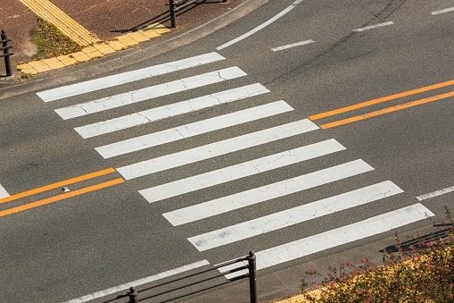FATAL PEDESTRIAN ACCIDENT STATISTICS
According to the Insurance Institute for Highway Safety (IIHS), which analyzed data from the U.S. Department of Transportation’s Fatality Analysis Reporting System (FARS), the number of pedestrians killed in collisions with motor vehicles is on the rise. Specifically, IIHS notes that pedestrian fatality accidents have increased over 50 percent since 2009, and pedestrian deaths account for nearly 20 percent of all people killed in fatal accidents.
According to statistics from the National Center for Health Statistics (NCHS), approximately 7,400 pedestrians lost their lives in crashes and collisions in 2018. This includes about 6,100 pedestrian deaths that occurred on public highways. The NCHS’s numbers also included those harmed in “non-traffic” accidents, which encompassed pedestrians killed on private driveways and in parking lots.
Where Do the Majority of Pedestrian-Motorist Crashes Occur?
The data provided by NCHS regarding fatal pedestrian crashes in 2018 shows that:
- The vast majority of fatal pedestrian accidents – 79 percent – occurred in urban areas as opposed to rural areas
- Nearly three-quarters of fatal pedestrian collisions took place away from an intersection. Only one-quarter of such collisions occurred at intersections
- 75 percent of fatal accidents involving pedestrians happened at night
- Friday night, Saturday night, and Sunday night all saw the highest number of incidents for pedestrian fatality accidents. During the daytime hours, a fatal pedestrian crash was more likely to occur on a weekday.
Some of these statistics are not surprising. Urban areas are more likely to have large numbers of pedestrians walking near roadways filled with vehicles. Similarly, nighttime limits the ability of motorists to see pedestrians. As a result, it is not surprising to see that collisions between pedestrians and vehicles are more frequent at night.
The interesting and surprising detail in the reports is that most pedestrian-vehicle accidents occur away from intersections. However, it should be remembered that this type of location may have poor lighting and little or no room for pedestrians to walk safely. Moreover, motorists might believe they are less likely to encounter pedestrians along roadways and highways and therefore, may allow their attention or focus to shift.
TRENDS IN FATAL PEDESTRIAN COLLISIONS
The data reviewed by the IIHSreport reveals that the number of pedestrian fatalities was on a general downward trend from 1975 until 2009. Since 2009, during which 4,109 pedestrians were killed, the number of pedestrian deaths has steadily increased and reached a high of 6,283 in 2018. This is the highest number of pedestrian deaths since 1990 (during which 6,482 pedestrians were killed). Pedestrian deaths in 2018 accounted for seventeen percent of all individuals killed in motor vehicle collisions, a percentage that was last reached in 1982.
Approximately 80 percent of all fatal pedestrian crashes occur in urban areas. This is not unexpected, considering that the populations of many cities increased from 1975 to 2018. Most fatal pedestrian wrecks occurred between the hours of 6 p.m. and 3 a.m., and the majority occurred on Friday and Saturday. The overwhelming number of fatal crashes were not “hit-and-run” accidents in which the motorist flees the scene of the wreck.
VISIBILITY IDENTIFIED AS A KEY FACTOR
Certain behaviors and choices by motorists are known to increase the risk of a pedestrian or bicycle collision. These include driving under the influence of alcohol or drugs, utilizing a smartphone or similar device while walking, biking, or driving, and speeding through downtown areas or areas where there is likely to be a high volume of pedestrians. Governing.com also highlights another factor believed to contribute to the high number of pedestrian fatalities: poor visibility.
FATAL PEDESTRIAN COLLISIONS MORE LIKELY AT NIGHT
The vast majority of fatal pedestrian collisions and fatal bicycle crashes happen at night. In a majority of these instances, there is either no lighting or only some lighting present. Moreover, almost three-fourths of fatal collisions involving bicyclists or pedestrians occur away from intersections and crosswalks. Lighting conditions along roadways are not always the best, making pedestrians difficult to spot in the dark. Even streetlights only illuminate the top of a pedestrian’s head, and not necessarily the remainder of the pedestrian’s body. Motorists also may not expect to encounter many pedestrians along roadways and highways at night, and so many not be looking as diligently as they should for pedestrians and bicyclists.
When Do Seven Out of Ten Pedestrian Fatalities Occur?
Governing.com recently analyzed data from the National Highway Traffic Safety Administration concerning the number of fatal accidents involving pedestrians and bicyclists. In Escambia County, Florida, for example, seven out of ten collisions that kill pedestrians or bicyclists from 2014 to 2017 occurred after dark. These statistics were not unusual when compared to statistics from other parts of the country or from national statistics.
MAKING ROADS SAFER FOR PEDESTRIANS
In local communities, law enforcement officers have begun distributing lights to cyclists and pedestrians alike in areas where fatality accidents occur. Even this simple step toward safety may have an impact on the number of individuals killed by motorists in the future.
The IIHS suggests that sidewalks, “refuge islands” in the middle of large highways, increased lighting, and other similar measures may reduce the incidence rate of pedestrian collisions. Also, the IIHS recommends that speed limits are reduced in populated areas may reduce fatal pedestrian crashes since the risk of fatal injuries increases when vehicles are traveling at higher speeds. Finally, the IIHS indicates that improvements to vehicles’ bumpers, hoods, and windshields, and integrate technologies designed to detect pedestrians in the vehicle's path and automatically apply the vehicles’ brakes, may be useful in mitigating the risk of deadly injuries to pedestrians.
NHTSA SAFETY TIPS FOR PEDESTRIANS
Walking is becoming an increasingly dangerous activity. The National Highway Traffic Safety Administration (NHTSA) estimates that over 6,000 pedestrians were killed in traffic collisions during 2018.
Those who choose to travel by foot may learn lessons from these statistics. Pedestrians who walk at night should consider wearing highly visible clothing, using sidewalks and road shoulders when available, and walking against the flow of traffic so they might be better positioned to avoid a collision.
SOME OF THE MOST COMMON WAYS IN WHICH THESE COLLISIONS OCCUR INCLUDE:
- A motorist strikes a pedestrian who steps out into the road midblock or at a place other than a crosswalk
- A driver hits a pedestrian who is crossing the street while the driver is making a turn
- The driver collides with a jogger, runner, or walker who is walking alongside the road
- A school bus or commercial bus passenger is hit by a car after they exit the bus and attempt to cross the street
HOW PEDESTRIANS MAY REMAIN SAFE ON AND NEAR THE ROADWAY
NHTSA(.pdf) recommends that pedestrians obey traffic laws, including “Don’t Walk/Walk” signals at crosswalks, and consider the following tips:
- Wear visible clothing during the day and reflective clothing at night
- Consider using a flashlight at nighttime
- Use sidewalks and pedestrian pathways where available
- Be alert for cars backing up when walking through a parking lot
- If no sidewalk or pathway is available, walk on the left and against traffic
- Refrain from using smartphones or portable devices while walking, as these can distract a pedestrian from potential dangers
- Cross at crosswalks whenever possible. If no crosswalk is available, pedestrians should cross at intersections or street corners with good visibility
- If it is not possible to cross the street at any of these locations, pedestrians should look for a place to cross where they can clearly see all traffic and cross only when it appears safe to do so.
While these safety tips may not prevent all pedestrian collisions, pedestrians who exercise caution and are alert to their surroundings may have a greater chance to avoid a potentially fatal collision with a motor vehicle.
SHOULD I RETAIN AN ATTORNEY FOLLOWING MY PEDESTRIAN ACCIDENT?
If you or a member of your family has sustained harm in a pedestrian accident caused by an unsafe driver, the best strategy to prevail in your personal injury or wrongful death case is to discuss your legal rights with a pedestrian accident lawyer. An Washington DC personal injury attorney from our law firm is able to review the facts of your claim, help you document your injuries, ensure important deadlines are met, and fight hard to recover the financial compensation your case deserves for accident-related injuries, losses, and damages. It is important to understand that being involved in a pedestrian accident with injuries is not as easy as simply collecting a settlement check from the at-fault party’s insurance company. A knowledgeable and effective legal professional can assist you in evaluating your claim´s value and help you take the essential steps to build your case against the responsible party.
FREE PEDESTRIAN ACCIDENT CONSULTATION AND CASE REVIEW
After an accident involving a negligent driver, coping with the legal process, insurance company claims negotiations, and dealing with the other party’s defense attorneys can make a challenging situation much more painful and stressful for you. That is why it is crucial that you contact a qualified legal advocate who has the knowledge and experience necessary to protect your legal rights and offer you the assistance you deserve when an accident has taken a toll on your life.
If you were injured or if your family lost a loved one in any type collision with injuries, Fay Law Group is ready to explain your legal rights. Contact our Washington DC pedestrian accident attorneys at (202) 589-1300 or contact us online for your free case review and consultation.

